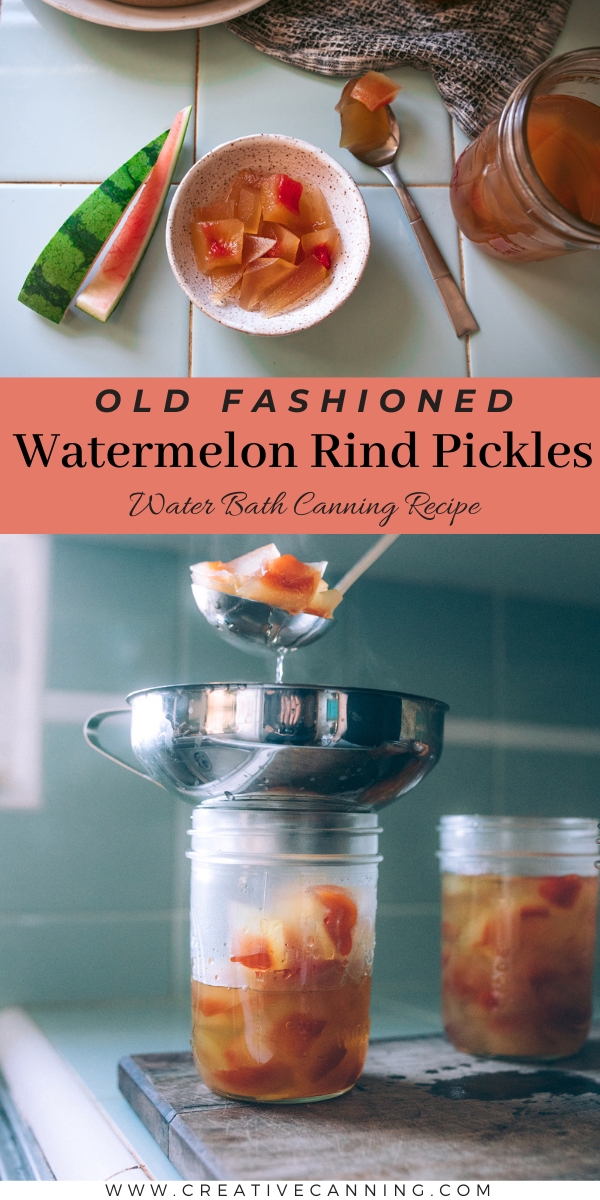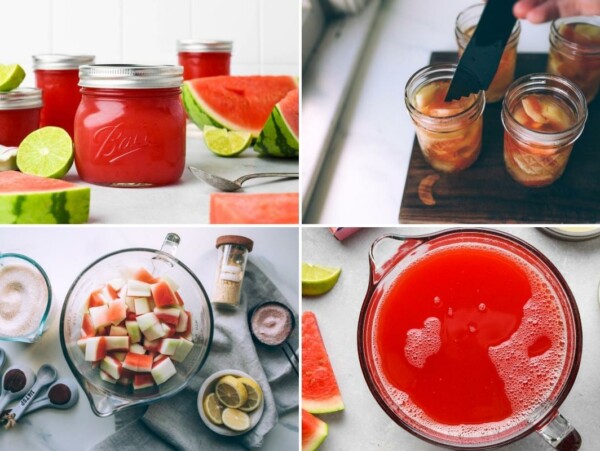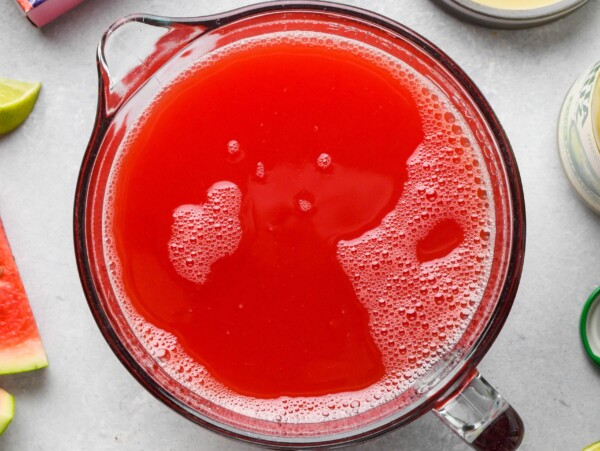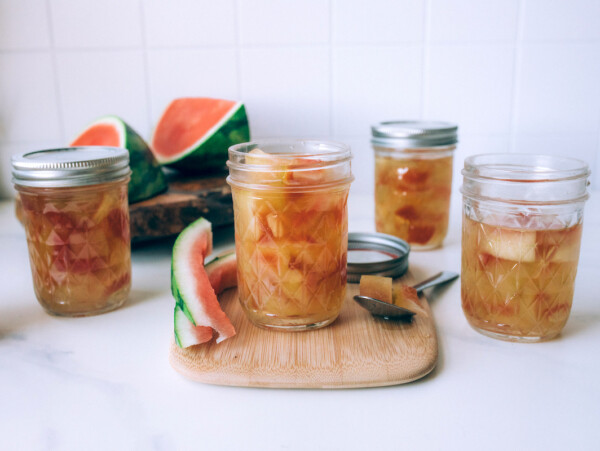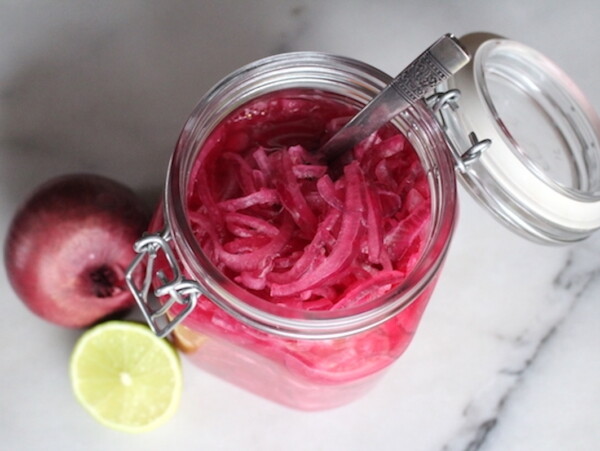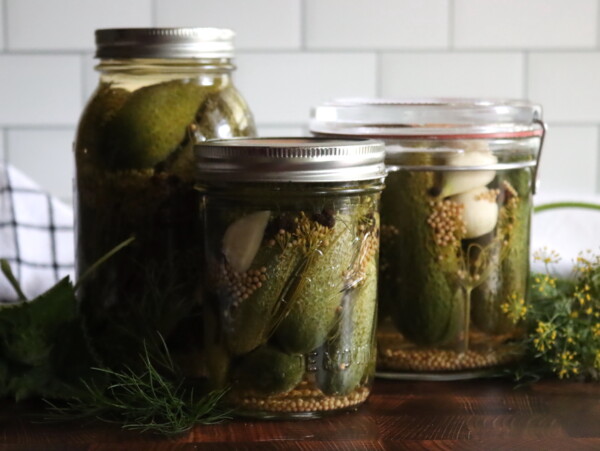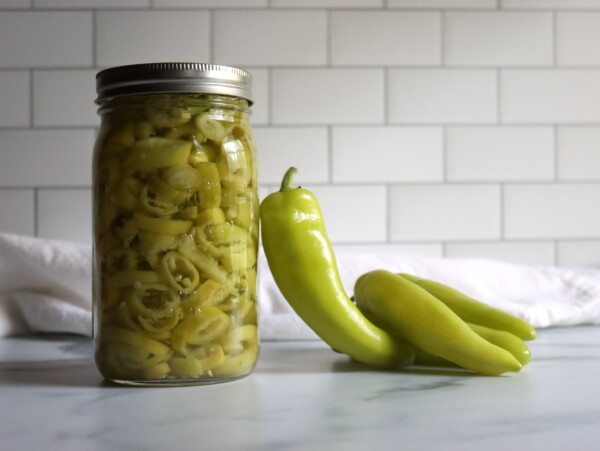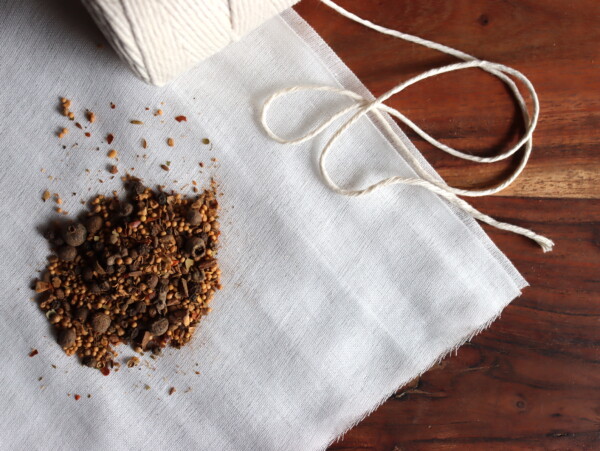This post may contain affiliate links. Please see our disclosure policy.
Watermelon rind pickles are an old-fashioned treat that’s worth saving space for in your modern pantry.
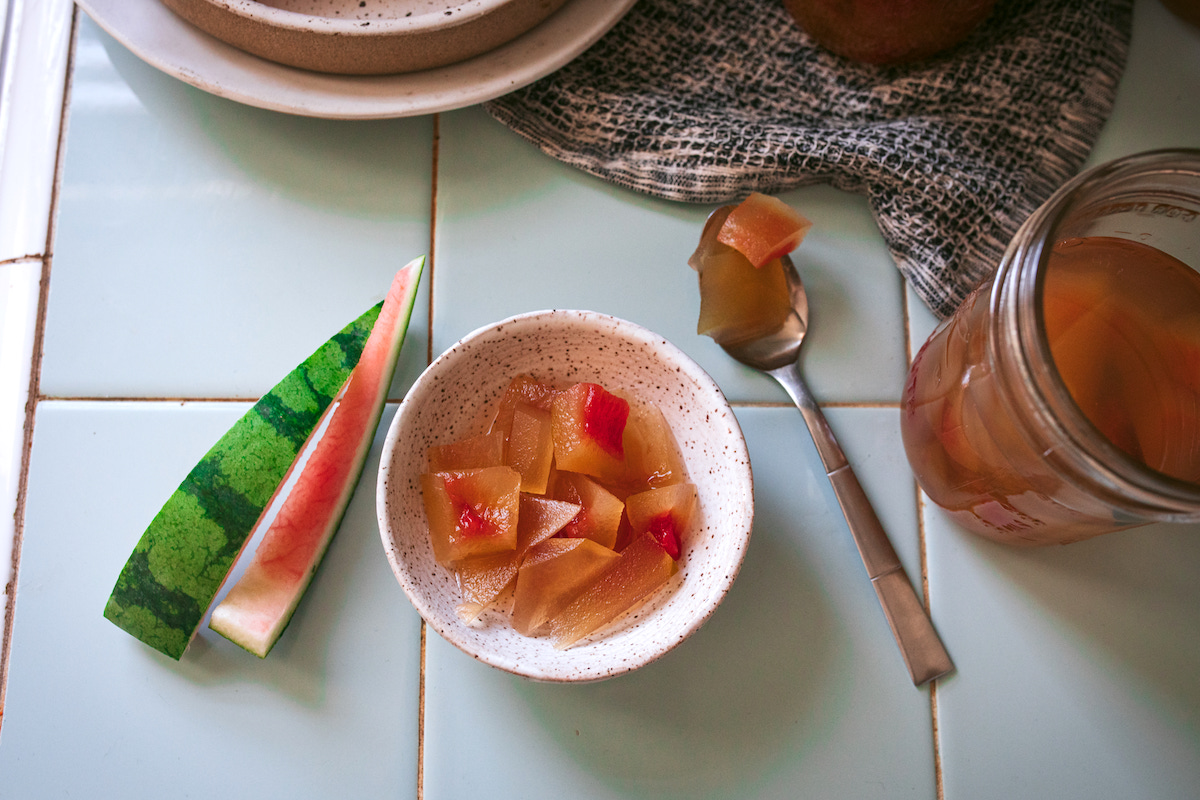
Table of Contents
Old-fashioned watermelon rind pickles date back to the pioneer era, and most people assume they are just a simple, albeit odd, practice in extreme frugality. Waste not, want not, right?
The thing is, the ingredients in watermelon rind pickles aren’t exactly inexpensive. Or, at least, they weren’t back in the day.
White sugar and cinnamon cost a pretty penny out on the frontier, and they were reserved for company. Why on earth are they using up costly sugar to preserve what would otherwise be a waste product relegated to the compost heap?
The answer? Watermelon rind pickles are surprisingly good, and they were worth making, even if it was costly at the time.
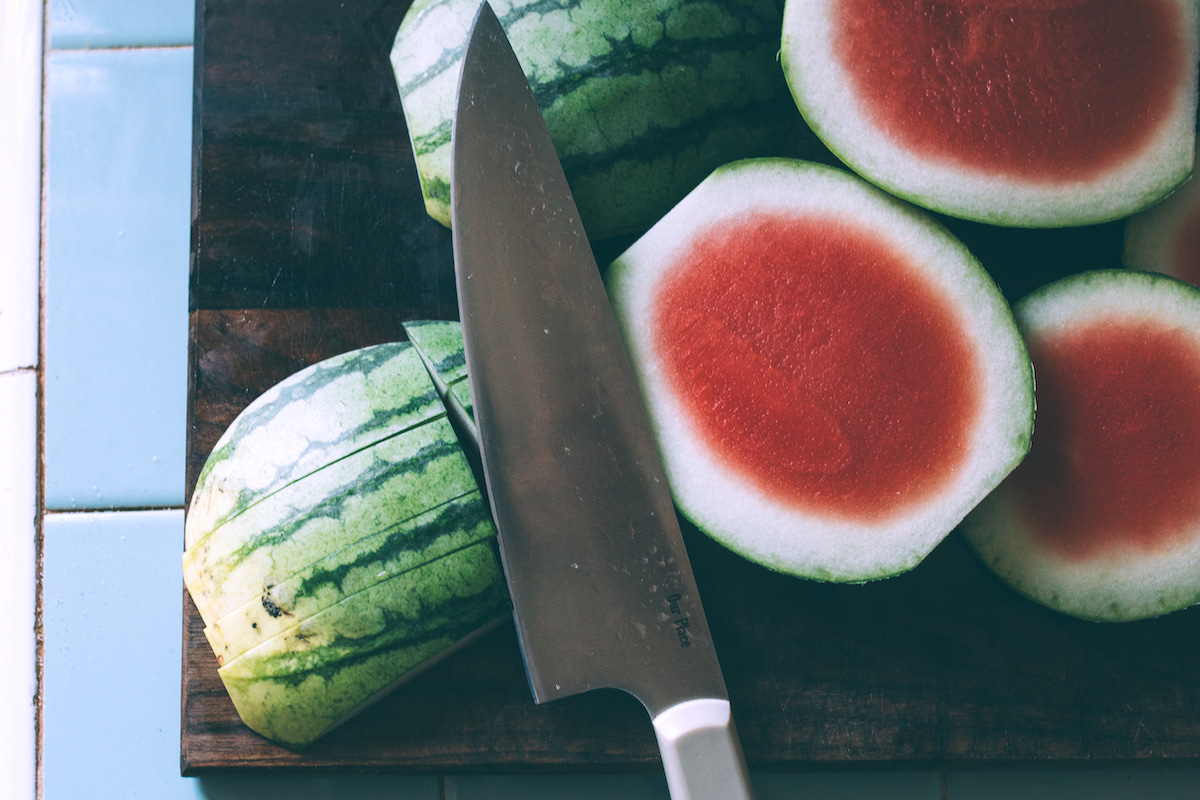
If you read the little house on the prairie books, you know what a treat pickles could be. For the most part, Laura’s family was surviving on a diet of cornmeal mush and salt pork, with some coarse flour biscuits on occasion. At one point, Pa goes into town and comes back with a special treat… store-bought crackers and pickles. Laura talks about slowly savoring the pickles, and describes them as though they were the best treat in the world.
And, they were! Or at least, pickled things would be, if your diet was as bland as hers had been for the past winter.
Pickles are a way to preserve flavor to add interest to an otherwise monotonous storage diet.
Sugar, salt, and spices may be expensive, but they don’t spoil, so you can get them on the frontier if you’re willing to pay for them. Using those basic ingredients, you can preserve the flavor and crunch of most anything, including watermelon rind.
Watermelon rind sounds strange, but it actually works out wonderfully well as a pickle. It softens just enough to be tasty, but stays crisp enough to be interesting. And best of all, it absorbs flavor really well.
We live in a time where you can get fresh pineapple on your table in January, but I’d argue that there’s still space for watermelon rind pickles in your pantry. They’re downright delicious and full of memories of another time and another world that existed not so long ago.
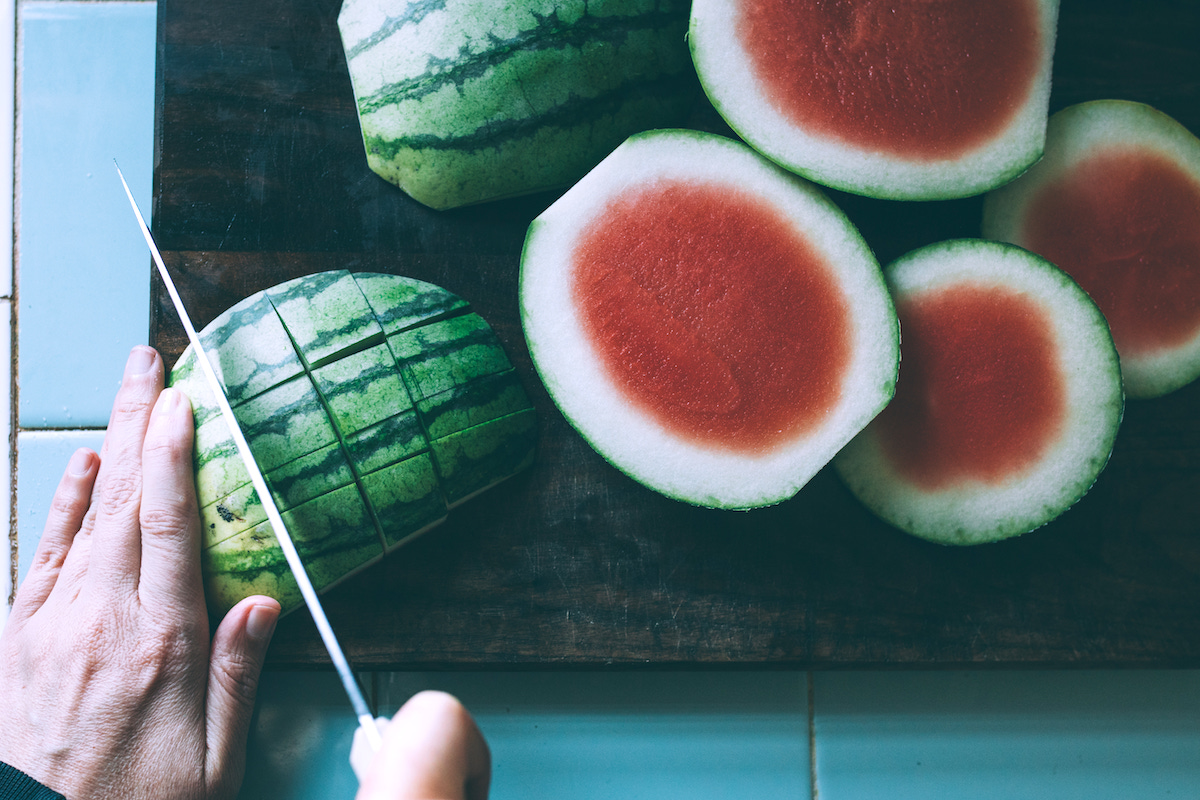
A Quick Look at the Recipe
- Recipe Name: Watermelon Rind Pickles
- Recipe Type: Fruit Pickling Recipe
- Canning Method: Waterbath Canning
- Prep/Cook Time: 4 hours
- Canning Time: 10 Minutes
- Yield: 4 to 5 pint jars
- Jar Sizes: Half Pint or Pint
- Headspace: 1/2 inch
- Ingredients Overview: Watermelon Rind, Vinegar, Salt, Sugar, Cinnamon, Cloves and Lemon.
- Difficulty: Moderate. This recipe requires a pre-soak, don’t skip it!
- Similar Recipes: The process is very similar to making other old fashioned fruit pickles, including: pickled cherries, pickled peaches, pickled blueberries and pickled strawberries.
What Are Watermelon Rind Pickles?
Watermelon rind pickles are made from the white pith and light pink flesh that sits just under the woody, green exterior of a watermelon. In this recipe, watermelon rinds are shocked in a cold brine overnight before being cooked until candy-sweet in a rich, tangy syrup.
As is traditional with watermelon rind pickles, the syrup is bolstered by the warm flavors of cinnamon, whole cloves, and pieces of thinly sliced lemon.
Ingredients for Watermelon Rind Pickles
If we’re not eating copious amounts of watermelon on its own as a snack, I like to make these watermelon rind pickles whenever I make a batch of watermelon jelly for canning. You’ll need 3 quarts or 6 pounds of unpared watermelon rind for this recipe, which will yield 4 or 5 pints of pickled rind.
- Watermelon rind
- Salt
- Ice cubes
- Sugar
- 5% white vinegar
- Whole cloves
- Cinnamon sticks
- One lemon
I’ve used pink Himalayan salt for this particular batch, but you could also add canning salt, sea salt, or kosher salt in its place.
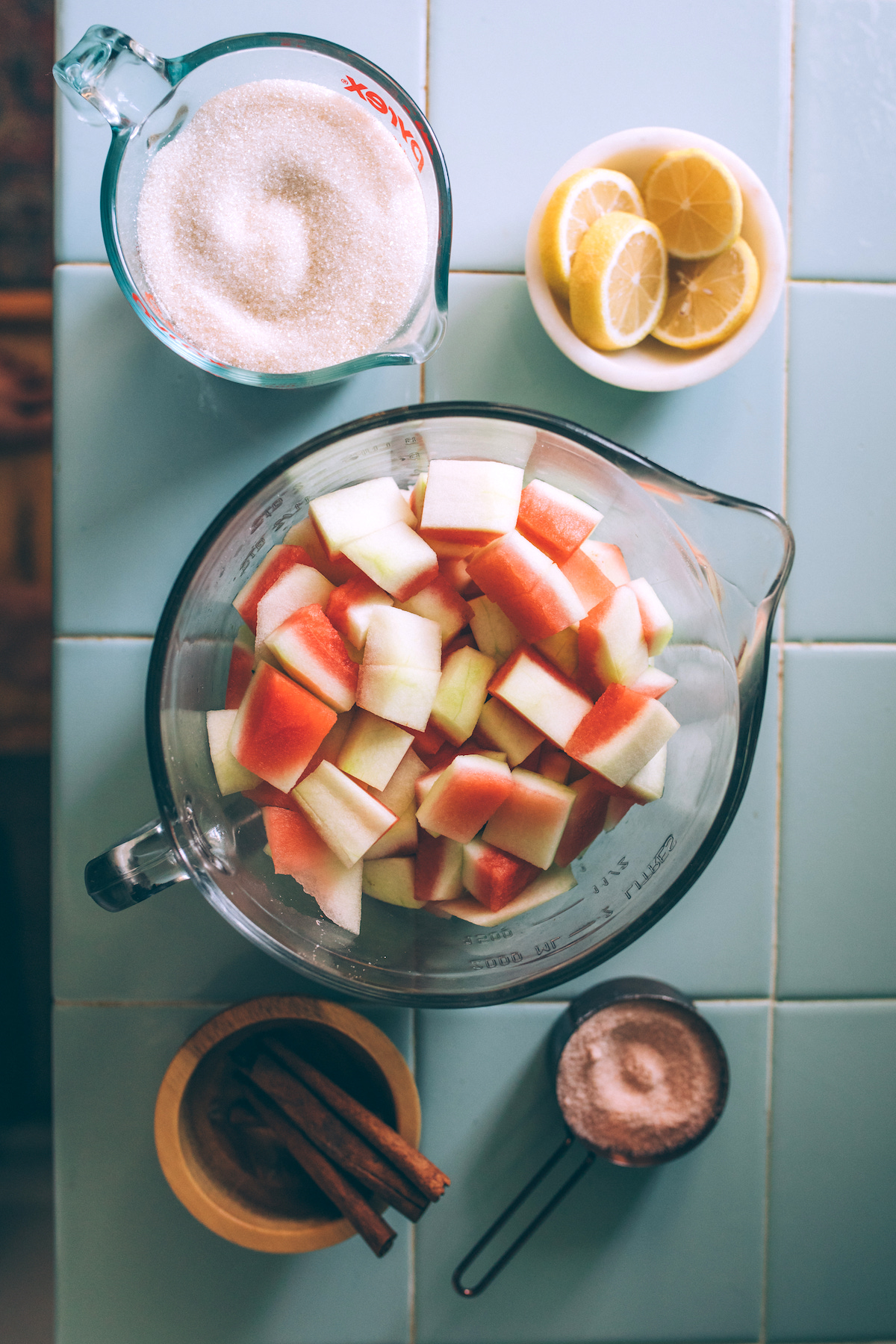
How to Make Watermelon Rind Pickles
Begin by measuring and gathering your ingredients. For the first part of the recipe, you’ll need 2 quarts, or two ice cube trays worth of ice cubes.
As I mentioned above, we’re going to begin with about 6 pounds or 3 quarts of the unpared watermelon rind. Using a sharp paring knife, remove the tough green exterior rind, leaving the white pith and traces of pink melon. Discard the rind and prepare the watermelon rind pieces for pickling by cutting them into squares that are roughly 1-inch across.

In a large mixing bowl or measuring cup, add 3/4 cup of salt to 3 quarts of cold water.
Whisk the salt and water together to dissolve, creating a brine for the watermelon rinds to soak in.
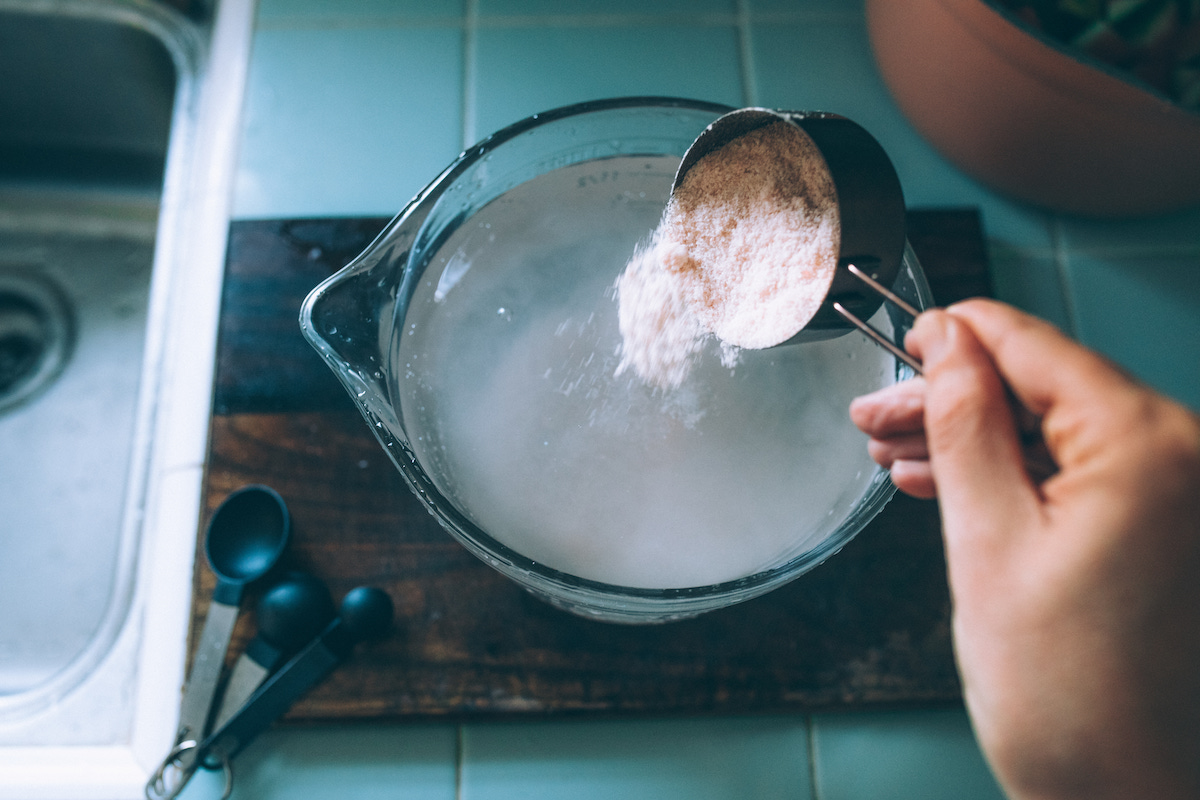
If you’re using a particularly coarse salt that won’t completely dissolve in cold water, you can always make a hot water brine using the same proportions of water and salt listed in the step above.
Once the salt is dissolved, the brine can be chilled and used in the recipe as directed (just make sure the brine is very chilled for this next step!)
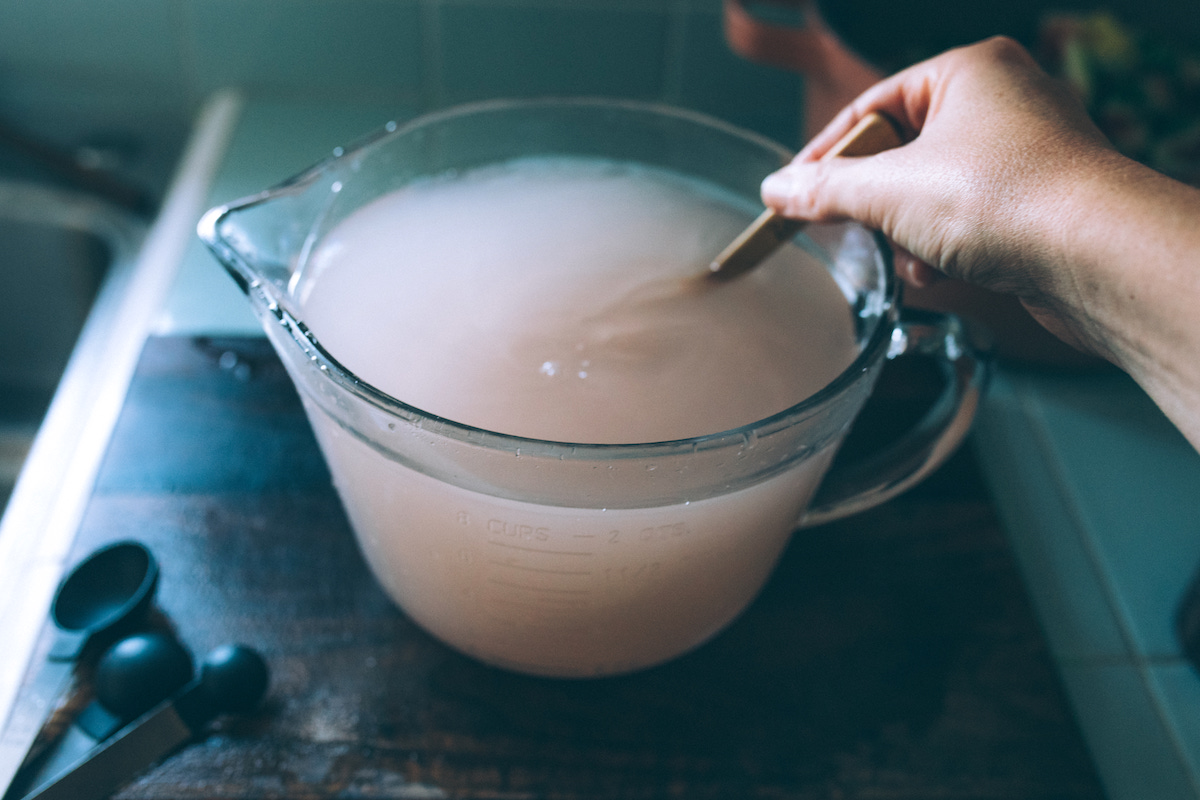
Add the pared melon rind directly to the cold brine and stir, make sure the rinds are completely submerged and covered. Cover the brine and rinds with about 2 quarts or two ice cube tray’s worth of ice, stirring to equally distribute the ingredients.
Set the bowl or measuring cup containing the rind, brine, and ice aside and let it sit for 3 to 4 hours in the fridge.
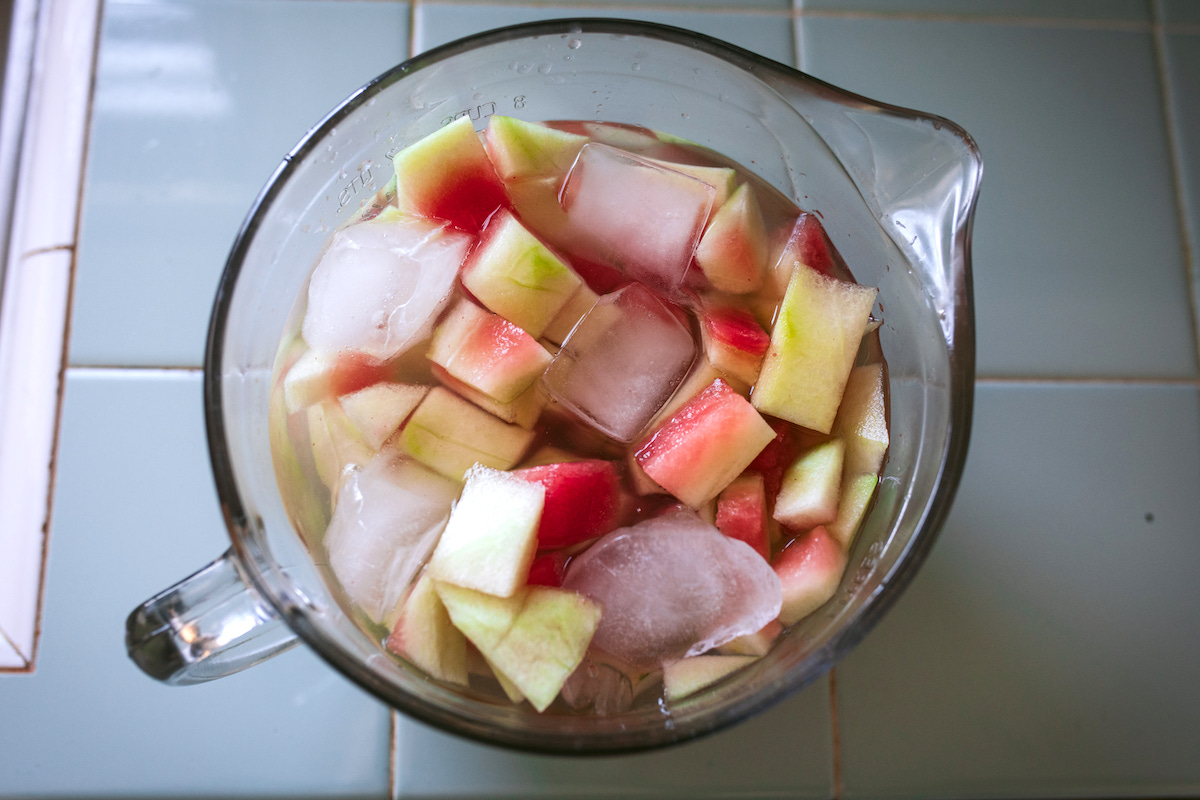
Drain the melon rind in a colander and rinse well with cold water. Transfer the soaked rinds to a large saucepan and cover with cold water. Bring the water to a rapid simmer and cook the rinds until fork tender, which usually takes about 10 minutes.
As soon as the rinds are fork tender (no later!) drain them once more in a colander and put them back in the original saucepan or a large, heat-proof bowl.
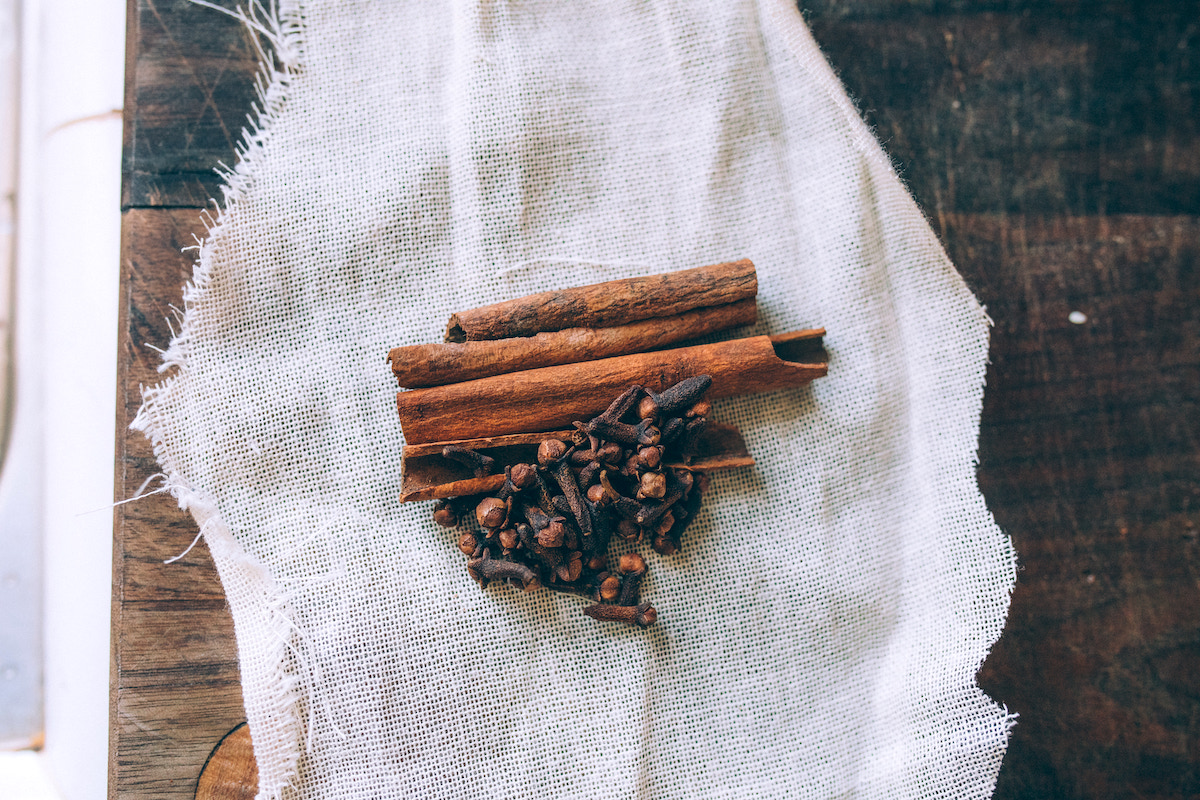
To add a hint of warm spices to the watermelon pickle, we will make a spice sachet to add to the vinegar brine. This will add flavor to the pickle without overpowering the taste of the finished rinds. Using a knife or kitchen shears, cut six cinnamon sticks into smaller pieces, wrap the cinnamon and 1 tablespoon of whole cloves into a scrap of cheesecloth, and tie to secure.
Add the spice sachet to another large saucepan along with 9 cups of sugar, 3 cups of white vinegar (with at least 5% acidity), and 3 cups of water. Bring this mixture to a boil and let it continue to boil for 5 minutes.

Pour the hot brine over the watermelon rinds and add 1 thinly sliced lemon with the seeds removed.
Stir everything to combine and store the saucepan (or bowl) in the fridge overnight.

The next day, place the saucepan and its contents on the stove and bring the ingredients to a boil. Turn the heat down and slowly cook the watermelon rinds for 1 hour, stirring occasionally.
At this point, the rinds will begin to take on a candy-like texture, and the syrup will begin to thicken as it simmers.
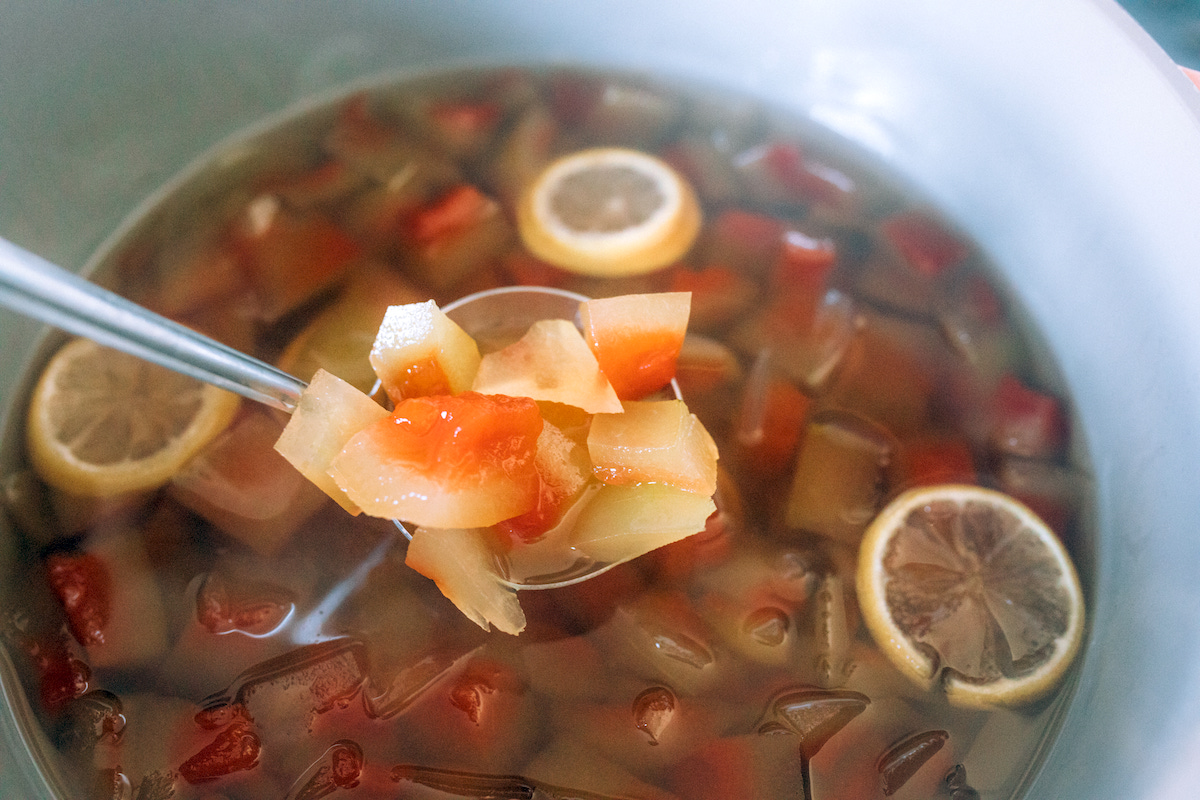
When the watermelon rinds are just starting to turn translucent around the edges it’s time to decant them into prepared pint jars. Remove the spice sachet bag from syrup and set aside to cool; we’ll be using its contents again shortly.
Using a ladle and a canning funnel, fill each pint jar with the hot pickles and brine, leaving 1/2-inch headspace at the top of each jar.
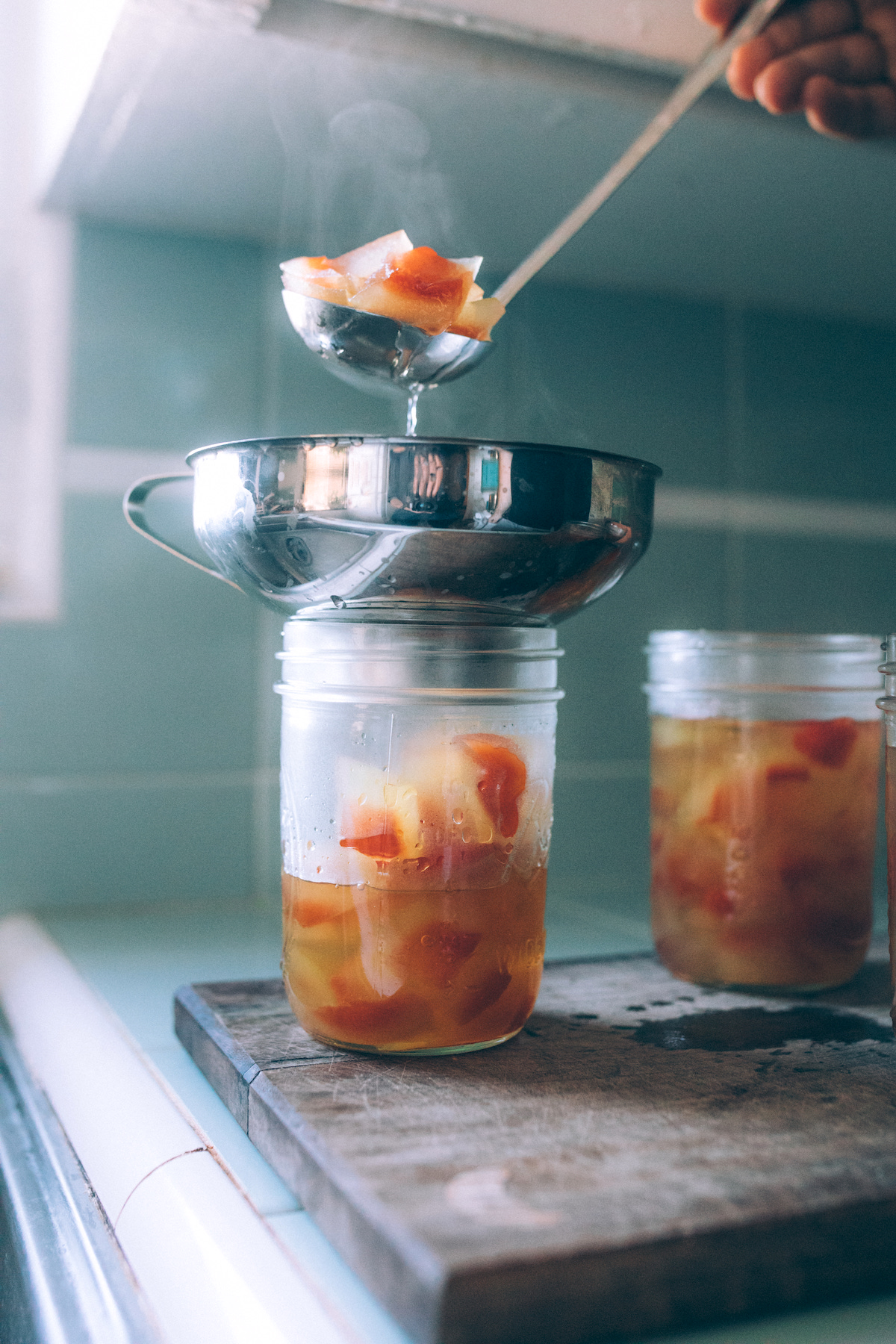
Add one piece of broken cinnamon from the spice sachet to each jar, making sure it’s also covered with hot syrup.
Use a wooden chopstick to break up any visible air pockets and readjust syrup levels if necessary so that the 1/2-inch headspace requirements are met.
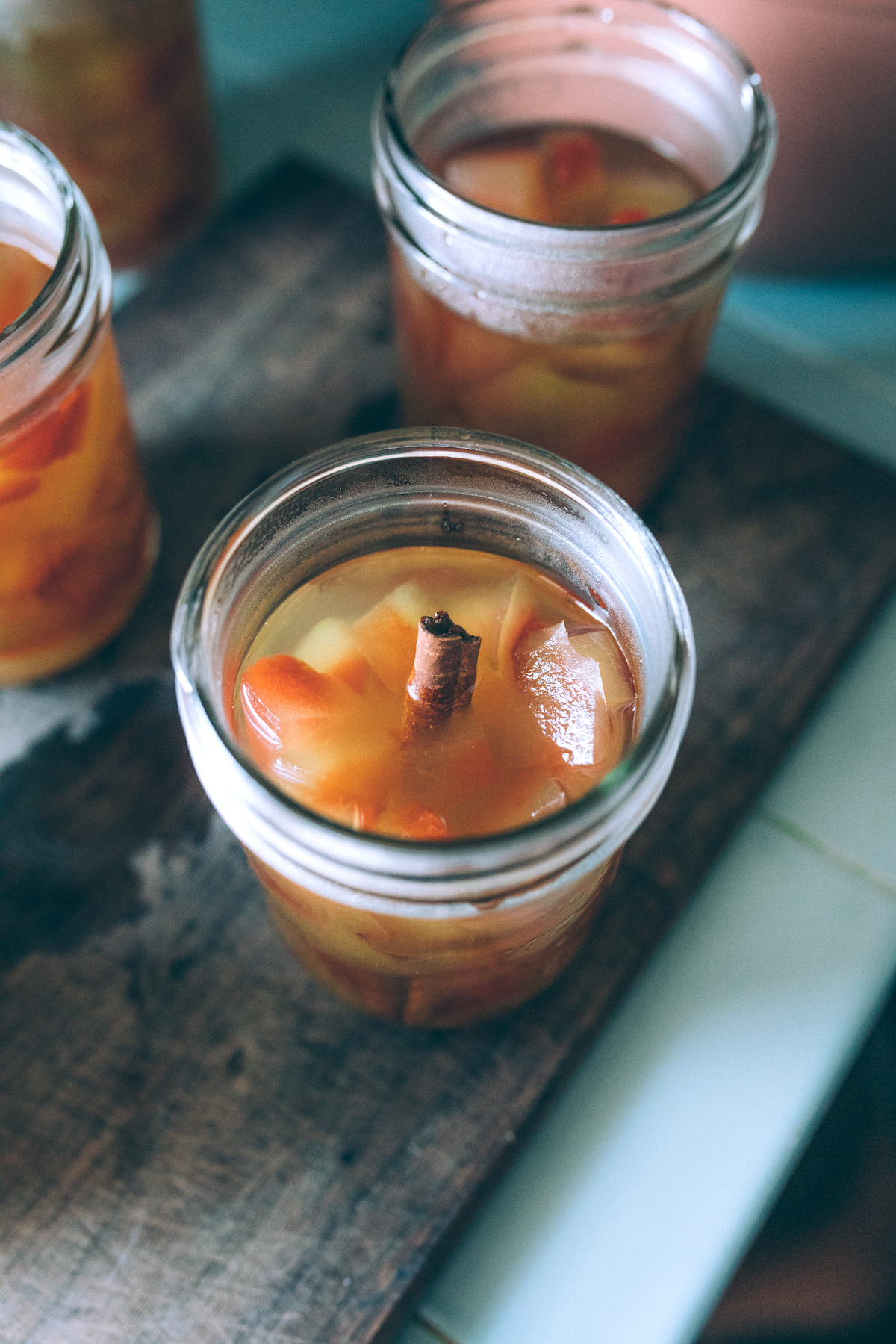
Use a clean kitchen towel to wipe down the sides and rims of each jar before applying two-piece metal canning lids until fingertip tight. At this stage, we’re ready to can these watermelon rind pickles in a hot water bath canner.
Canning Watermelon Rind Pickles
Load the prepared pint jars into a hot water bath canner, making sure each jar is covered by at least 1-inch of hot water.
Process the jars for 10 minutes, adjusting for altitut* and then transfer to a clean kitchen towel—leaving at least 1 inch between each jar—and allow the watermelon pickle to come to room temperature (this usually takes anywhere between 12 and 24 hours).
Check the seal on each jar, storing any unsealed jars in the fridge. Sealed watermelon rind pickles can be stored in a cool, dry place away from direct light for up to 18 months.
*15 minutes if you live at an altitude between 1,001 and 6,000 feet; 20 minutes if you live at an altitude greater than 6,000 feet.
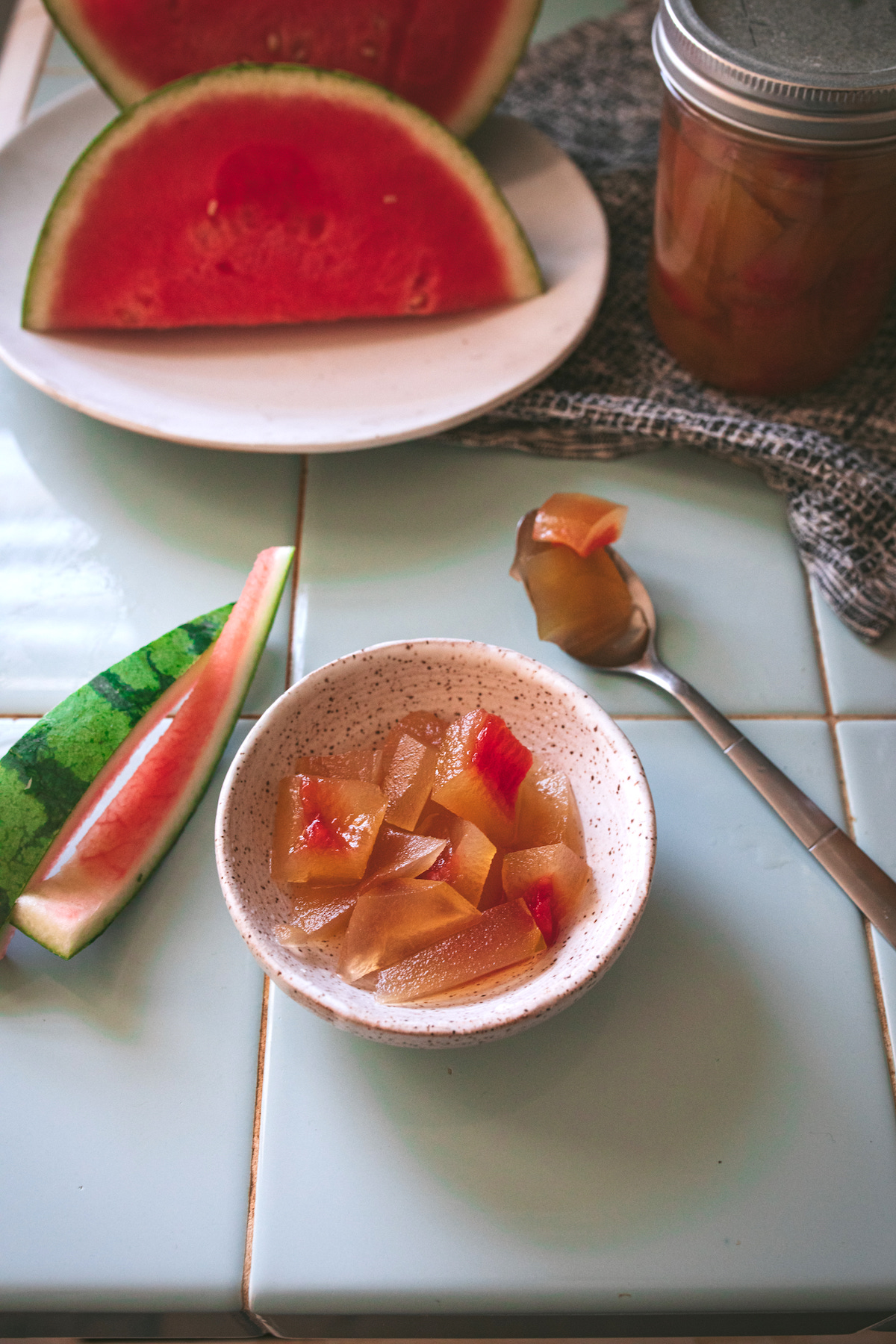
Ways to Use Watermelon Rind Pickles
Pickled watermelon rind is a surprisingly versatile condiment, with uses ranging from cocktail garnishes to a charcuterie accompaniment. I think they pair exceptionally well with roasted pork, wild boar, or duck—especially as a complement to fattier cuts of meat.
Watermelon rinds make an interesting addition to salads, particularly coleslaws and kale salads. To use, simply chop finely or slice thinly. If you want an extra zippy salad, you can also use a few tablespoons of the syrup as part of the dressing.
Of course, this particular recipe for watermelon rind pickles is delicious on its own, enjoyed straight from the jar while standing in front of the fridge!
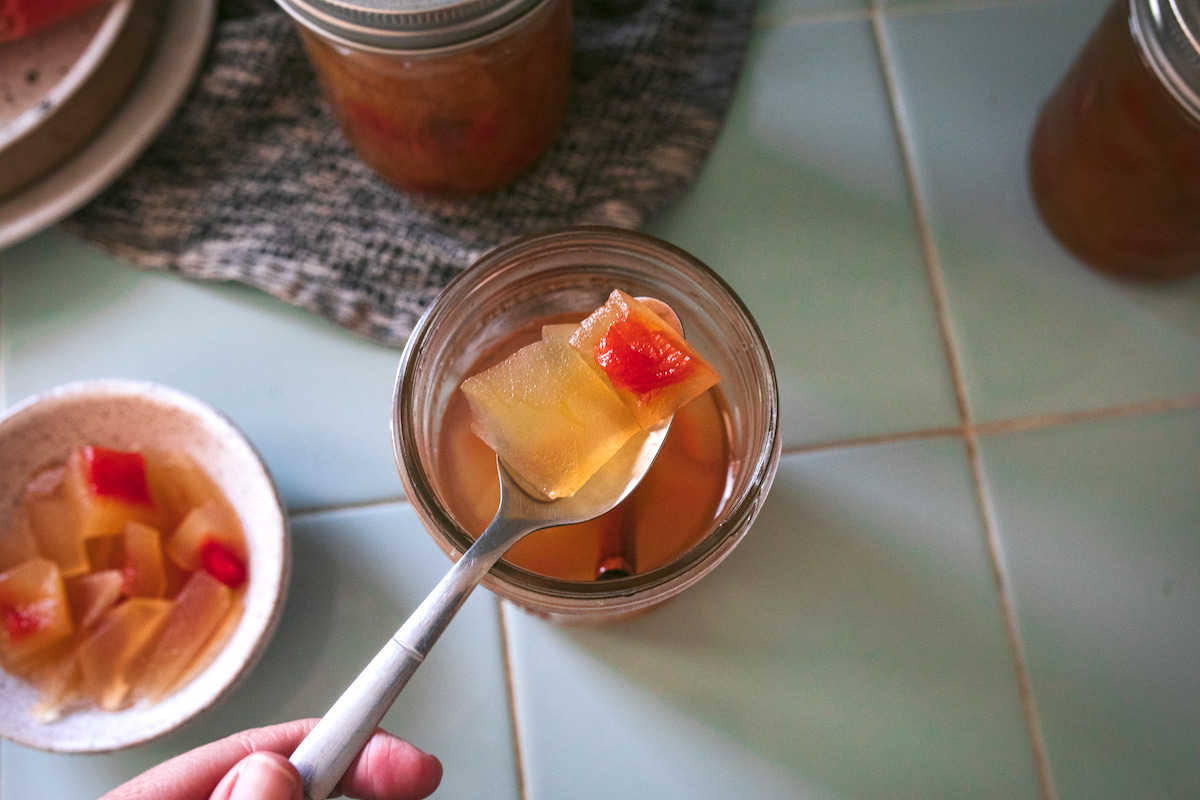
If you tried this Watermelon Rind Pickles Recipe, or any other recipe on Creative Canning, leave a ⭐ star rating and let me know what you think in the 📝 comments below!
And make sure you stay in touch with me by following on social media!
Melon Canning Recipes
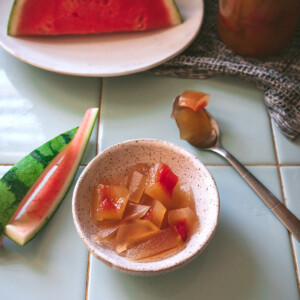
Watermelon Rind Pickles
Equipment
Ingredients
- 3 Quarts watermelon rind, about 6 lbs
- 3/4 cup salt, Himalayan, kosher, sea salt, etc.
- 3 Quart water
- 2 Quart ice cubes, about 2 trays
- 9 cups sugar
- 3 cups White vinegar, at 5% acidity
- 3 cups water
- 1 Tbsp. whole cloves
- 6 whole cinnamon sticks, broken or cut into 1-inch pieces
- 1 whole lemon, thinly sliced with seeds removed
Instructions
- Using a sharp paring knife, remove green outer rind from watermelon rinds. Cut rind into 1-inch squares.
- Make a cold water brine by mixing together the salt and 3 quarts of cold water, stirring to completely dissolve the salt.
- Cover the watermelon with the cold brine and ice cubes. Stir and let sit for 3-4 hours.
- Drain and rinse the watermelon rind under cold water in a colander.
- Add the watermelon rind back to the sauceoan, cover with cold water, and bring the water to a boil for 10 minutes or until fork tender. Drain. Add the watermelon back to the saucepan or a large heat-proof bowl.
- In another saucepan, combine sugar, vinegar, 3 cups of water, and spice sachet*. Boil for 5 minutes.
- Pour the syrup/spice sachet over the watermelon rind. Stir in sliced lemon. Let the watermelon rinds and syrup stand overnight in the fridge.
- The next day, heat the watermelon, spice sachet, syrup, and lemon slices in a large saucepan until boiling. Lower the heat and slowly cook the rind for 1 hour.
- Pack pickled watermelon rinds in prepared pint jars. Ladle over hot syrup, leaving 1/2-inch headspace. Remove air bubbles with a wooden chopstick and adjust syrup as needed to fulfil headspace requirements.
- Wipe each jar and jar rim with a clean kitchen towel before two-piece metal canning jars until fingertip tight.
- Load jars into hot water canner and process for 10 minutes**, covering jars with at least 1-inch of water.
- Remove jars from hot water canner with tongs, transferring them to a clean kitchen towel-lined space, leaving an inch of space between each jar. Let the contents of the jars come to room temperature (between 12-24 hours).
- Check the seal of each metal jar lid, transferring any unsealed jars to the fridge. Jars with sealed lids can be stored in a cool, dry place away from direct light for up to 18 months.
Notes
Nutrition
Nutrition information is automatically calculated, so should only be used as an approximation.
The lovely photography in this post is by Stephanie at My Tiny Laguna Kitchen.
Summer Canning Recipes
Keep your canner going this summer with these seasonal canning recipes!
Unique Pickling Recipes
Watermelon rind pickles are indeed unique, but they’re not the only specialty pickle you can make at home. Try these fun pickling recipes!
